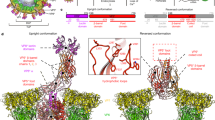Summary
A vaccinia virus-specific cytotoxic protein (3−10×104 daltons) had previously been detected in extracts of infected HeLa cells. In this study the protein has been shown to be a late gene product and a virion component — almost certainly the monomer of the surface tubules of the vaccinia virion. The relationship of this cytotoxin to a number of early vaccinia-induced cytopathic effects was examined: it was not the mediator of vaccinia-induced early cell rounding, did not inhibit protein or RNA synthesis in cell-free systems or intact cells (after uptake-induction by hypertonic MgSO4), or cause the release of β-glucuronidase from a crude preparation of HeLa cell lysosomes. Its possible role in vaccinia-induced cell degeneration, late in infection, is discussed.
Similar content being viewed by others
References
Allison, A. C., Malluci, L.: Histochemical studies of lysosomes and lysosomal enzymes in virus-infected cell cultures. J. exp. Med.121, 463–475 (1965).
Bablanian, R.: The prevention of early vaccinia-virus-induced cytopathic effects by inhibition of protein synthesis. J. gen. Virol.3, 51–61 (1968).
Bablanian, R.: Studies on the mechanisms of vaccinia virus cytopathic effects: effect of inhibitors of RNA and protein synthesis on early virus-induced cell damage. J. gen. Virol.6, 221–230 (1970).
Bablanian, R.: Structural and functional alterations in cultured cells infected with cytocidal viruses. Prog. med. Virol.19, 48–83 (1975).
Ben-Hamida, F., Chapeville, F., Beaud, G.:In vitro study of vaccinia virusinduced shut-off of host protein synthesis. In:Haenni, A. L., Beaud, G. (eds.),In vitro Transcription and Translation of Viral Genomes. INSERM47, 355–362 (1975).
Cukor, G., Solotorovsky, M., Kuchler, R. J.: Biological activity of heated diphteria toxin. J. Bact.115, 277–283 (1973).
Ichihashi, Y., Dales, S.: Biogenesis of poxviruses: interrelationship between haemagglutinin production and polykaryocytosis. Virology46, 533–543 (1971).
Jungwirth, C., Joklik, W. K.: Studies on early enzymes in HeLa cells infected with vaccinia virus. Virology27, 80–93 (1965).
Lowry, O. H., Rosebrough, N. S., Farr, A. L., Randall, R. J.: Protein measurement with the Folin phenol reagent. J. biol. Chem.193, 265–275 (1951).
McAuslan, B. R.: Control of induced thymidine kinase activity in the poxvirus-infected cell. Virology20, 162–168 (1963).
Orlov, G., Gancheva, T. Z., Kavaklova, L., Vacheva, V.: Method for the purification and concentration of vaccinia virus. Zbl. Bakt. Hyg. I. Abt., Orig. A.222, 174–179 (1972).
Paoletti, E., Rosemond-Hornbeak, H., Moss, B.: Two nucleic acid-dependent nucleoside triphosphate phosphohydrolases from vaccinia virus. Purification and characterisation. J. biol. Chem.249, 3273–3280 (1974).
Rothman, J. E., Lenard, J.: Membrane assymetry. Science195, 743–753 (1977).
Shida, H., Tanabe, K., Matsumoto, S.: Mechanism of virus occlusion into A-type inclusion during poxvirus infection. Virology76, 217–233 (1977).
Stephen, J., Birkbeck, T. H., Woodward, C. G., Wolstenholme, J.: Vaccinia virus cytotoxin(s). Nature (London)250, 236–238 (1974).
Stern, W., Dales, S.: Biogenesis of vaccinia: isolation and characterisation of a surface component that elicits antibody suppressing infectivity and cell-cell fusion. Virology75, 232–241 (1976).
Stern, W., Dales, S.: Biogenesis of vaccinia: relationship of the envelope to virus assembly. Virology75, 242–255 (1976).
Thacore, H., Wolff, D. A.: Activation of isolated lysosomes by poliovirus-infected cell extracts. Nature (London)218, 1063–1064 (1968).
Weber, K., Osborn, M.: The reliability of molecular weight determinations by dodecylsulphate—polyacrylamide gel electrophoresis. J. biol. Chem.244, 4406 to 4412 (1969).
Weber, L. A., Feman, E. R., Baglioni, C.: A cell-free system from HeLa cells active in initiation of protein synthesis. Biochem.14, 5315–5321 (1975).
Wolstenholme, J., Burgoyne, R. D., Stephen, J.: Studies on the MgSO4-induced cytoplasmic uptake of proteins by cells in culture. Exp. Cell Res.104, 377–388 (1977).
Wolstenholme, J., Woodward, C. G., Burgoyne, R. D., Stephen, J.: Vaccinia virus cytotoxin. Arch. Virol.53, 25–37 (1977).
Wu, G. J., Zubay, G.: Prolonged transcription in a cell-free system involving nuclei and cytoplasm. Proc. Nat. Acad. Sci. U.S.A.71, 1803–1807 (1974).
Author information
Authors and Affiliations
Rights and permissions
About this article
Cite this article
Burgoyne, R.D., Stephen, J. Further studies on a vaccinia virus cytotoxin present in infected cell extracts: Identification as surface tubule monomer and possible mode of action. Archives of Virology 59, 107–119 (1979). https://doi.org/10.1007/BF01317900
Received:
Accepted:
Issue Date:
DOI: https://doi.org/10.1007/BF01317900



